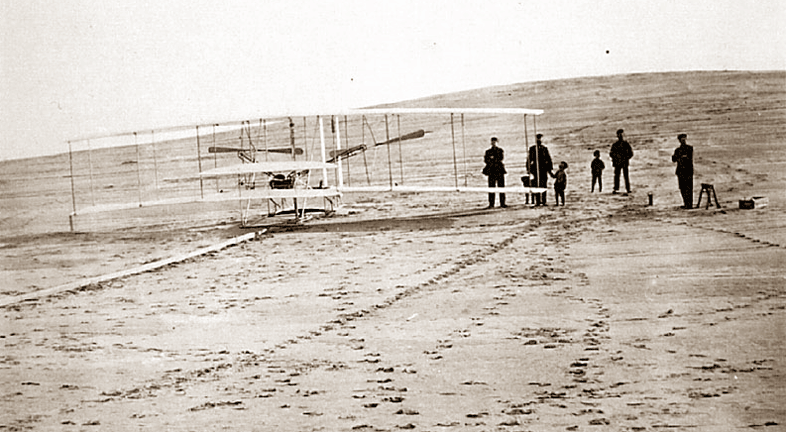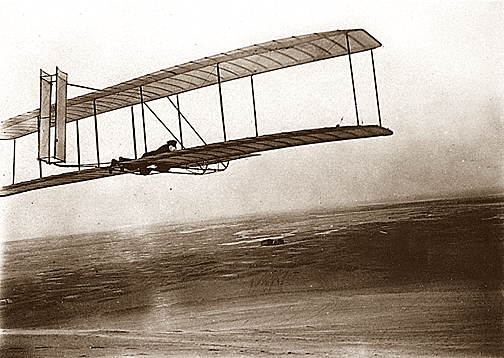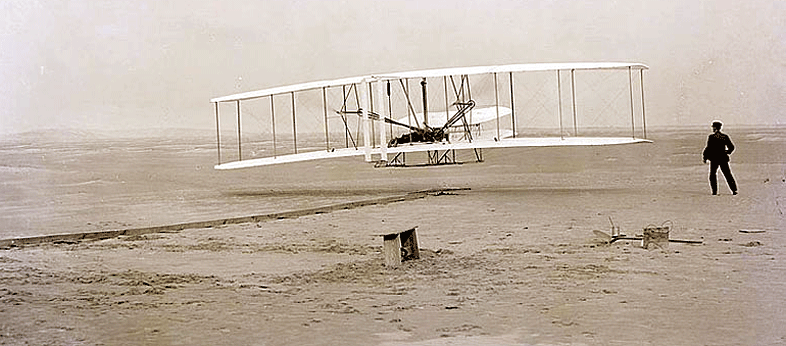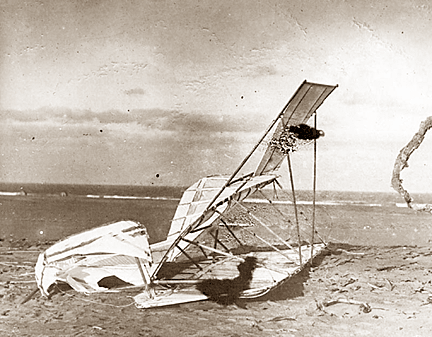|
At
around 1:30 on December 14, they hung a small flag from their work shed,
which the surfmen at the lifesaving station promptly spotted. Before long,
Bob Westcott, John Daniels, Tom Beacham, Willie Dough, and "Uncle"
Benny O'Neal came over to help move the Flyer a quarter mile to the intended
launch site.

For launching, the Flyer sat atop a small carriage that
ran along a 60-foot monorail. Built in four 15-foot sections, Wilbur
jokingly christened it the "junction railroad." Faced with moving
the Flyer across a flat stretch of sand and part way up the side of the dune
from which they planned to launch, the Wrights and their helpers that day
apparently laid the junction railroad outside the hangar, pushed the Flyer
60 feet along the track, dug up the last 15-foot section, placed it in front
of the Flyer, moved another 15 feet, dug up the last rail, placed it in
front of the Flyer, moved another15 feet, and so on. It was a laborious
quarter-mile.
The "trucks," on which the sled-like skids of
the machine rested, consisted of a plank about six feet long laid across a
smaller piece of wood to which were attached two small wheels, one in front
of the other. These were modified hubs from the wheels of a bicycle. The
rail itself was two by four inches, set on edge, the upper surface covered
by a thin strip of metal.
With the airplane's skids placed firmly on the launching
dolly, they set about preparing her for flight. By now, the audience
included two small boys and a dog, all three of whom scurried away when the
engine clattered into life, emitting angry puffs of smoke.
 Wilbur
and Orville flipped a coin for the honor of piloting the powered machine.
Wilbur won. He clambered onto the lower wing, settling his hips snugly in
the cradle that activated the wing-warping mechanism. He nodded. All set.
Time to go. Wilbur
and Orville flipped a coin for the honor of piloting the powered machine.
Wilbur won. He clambered onto the lower wing, settling his hips snugly in
the cradle that activated the wing-warping mechanism. He nodded. All set.
Time to go.
Orville stood at one wing tip, but the Flyer started down
the track before Orville was ready. He grabbed hold of an upright and began
running with the machine, but it outpaced him within 35 or 40 feet and
lifted shortly afterwards. Wilbur made the mistake of directing the craft
upward just past the end of the track, when it barely had enough speed to be
airborne. The great wings shivered as if eager to get aloft. Then - lift!
The Flyer rose from the track with an uncertain dignity,
attaining an altitude of perhaps 15 feet about 60 feet out, then began to
lose speed and dip toward the ground. The left wing struck first. The skids
dug into the sand, and some braces and struts for the elevator broke on
impact. The craft had covered 105 feet in three and a half seconds. No more
than a hop, in fact. They would have to do better. Much better.
The Wrights never considered calling the attempt that day
a powered flight, since in addition to being started down an incline, it was
short and poorly controlled. Nonetheless, they now had complete confidence
in their ability to fly. No wind on December 16 forced postponement of their
next flight.
But Thursday, December 17, dawned with a roar. A north
wind battered the Wrights' camp. Casting worried glances at the turbulent
sky, the brothers emerged, as natty as ever in suits, peaked caps, stiff
white collars, and ties. The Wrights aimed to be home by Christmas, and they
had to take advantage of what opportunities they had left. They tacked up
their flag to summon the lifesavers.
 It was now Orville's turn. He got aboard the lower wing
and tested the controls. The Wrights' aspirations didn't end with coaxing
the Flyer into the air. They wanted as much flight data as they could
gather. They rigged it with an anemometer, a stopwatch, and an engine
counter, so as to calculate "the distance through the air, the speed,
the power consumed, and the number of turns of the screws," as Wilbur
put it. It was now Orville's turn. He got aboard the lower wing
and tested the controls. The Wrights' aspirations didn't end with coaxing
the Flyer into the air. They wanted as much flight data as they could
gather. They rigged it with an anemometer, a stopwatch, and an engine
counter, so as to calculate "the distance through the air, the speed,
the power consumed, and the number of turns of the screws," as Wilbur
put it.
A
flurry of waving hands from the lifesaving crew. A nod of encouragement from
Wilbur. Orville released the restraining wire.
As the little engine clattered, the Flyer began to trundle along the track,
vibrating, rattling, and straining. Wilbur trotted alongside to steady the
right wing tip. About 40 feet along the track, at a ground speed of
approximately 6 mph the craft rose, dipped, climbed, then settled down far a
smooth landing on the sand. It had lasted 12 seconds and covered 120 feet.
The Flyer had moved forward under its own power and landed
at a point as high as that from which it began. It was overĖthe world's
first powered, controlled flight.
They flew three more times that day, but it was Wilburís
flight at Noon that made history. The Flyer started off on an undulating
course, as before, but straightened out after 300 or 400 feet until Wilbur
succeeded in covering 852 feet and remained aloft for a remarkable 59
seconds. But he landed hard and damaged the elevator. The lifesaving team
helped carry the aircraft back to the campsite, where the brothers intended
to repair the damage to the elevator and then make more flights.
 They
didn't get the chance. As they neared the camp, a violent gust of wind
caught the machine rolling it over and over causing irreparable damage. They
didn't get the chance. As they neared the camp, a violent gust of wind
caught the machine rolling it over and over causing irreparable damage.
If it wasnít for the accident to the plane after the
four flights were over, the brothers would have tried to fly to the Kitty
Hawk weather station four miles way. Their gasoline tank, though only a foot
long by three inches in diameter, held half a gallon. Since the machine with
operator weighed only about 750 pounds, one filling of the tank would have
lasted, they estimated, 18 minutes and taken them at least 10 miles.
A surprising thing was that despite the historic
importance that man could fly, there was no trace of excitement at the scene
of the flights, least of all by the Wrights, themselves. They had done only
what they had expected to do. The others present didnít then realize what
an event they had witnessed. But all too soon the whole world would know.
Historic photographs courtesy of the Library of Congress and Wright
State University.
Read a related article
<
Back to Special Features
|
